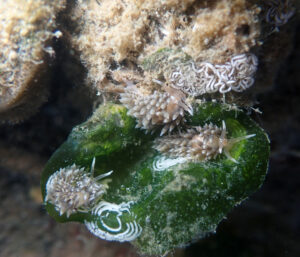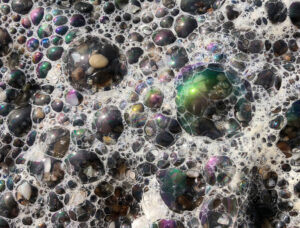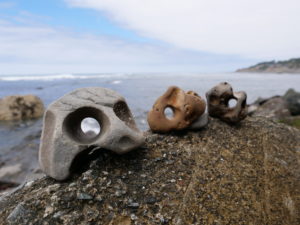To see a World in a Grain of Sand
And a Heaven in a Wild Flower,
Hold Infinity in the palm of your hand,
And Eternity in an hour.
In these famous lines from a poem he wrote more than 200 years ago, William Blake reminds us of the importance of small things, especially in nature. But he probably didn’t know there really is a world between the grains of sand along the ocean shore. Did you know there may be thousands of tiny animals in that handful of damp sand you picked up by the water?
Though it’s fun for us to play where the waves wash onto shore, it’s pretty hard for animals to live there: There’s no stable ground, and large areas flood or dry out as the tide changes. But, in fact, tiny animals are able to make their homes in the moist spaces between grains of sand at the water’s edge.
These creatures are called meiofauna (pronounced MY-oh-FAWN-uh), a word that refers to their small size. The largest meiofauna are smaller than the period at the end of this sentence–too small to see with our naked eyes. Under a microscope, some look like bristly worms or shrimp, and one looks enough like a pudgy hairless bear that it’s called a water bear.
Even though they’re tiny, meiofauna are important members of the beach environment. They help keep beaches clean by eating bits of even tinier dead organisms, and they in turn are food for other animals.
Since meiofauna are hard to see without a microscope, you might want to look for slightly larger sand animals. But even those can be a challenge to find.
For example, you won’t find beach hoppers if you look during the day. That’s when they stay moist and cool by burrowing into the sand in the “splash zone” above the high tide line. But with a flashlight at night, you may see thousands of them hopping about and eating beach wrack (piles of washed-up kelp and other ocean debris).
Beach hoppers resemble inch-long grayish-white shrimp with long red-orange antennae. They’re tasty morsels for many larger animals, especially birds–another good reason for them to stay buried during the day. If they’re disturbed, they dig rapidly into the sand head first.
Another beach animal that burrows rapidly is the sand (or mole) crab. But it burrows backwards. In fact, sand crabs can only move backwards, whether they’re digging, crawling, or swimming. Their burrows are in the “swash zone,” where the waves wash up and back on the beach. Because the tide is always changing, the crabs must move and rebury themselves often to stay in that zone.
In their burrows, they stand on end with only their long-stalked eyes and feathery antennae above the surface. As the water from a wave recedes, they extend their antennae and filter out tiny plankton to eat. It’s rare to see live sand crabs outside their burrows, but people who dig fast know they’re egg-shaped, grayish, and up to an inch and a half long. The bigger ones are the females, who carry thousands of orange eggs attached to their abdomens in the summer.
Sand crabs have good years and bad years. Some years millions of them pack together on a beach, and some years there are only a few. But even in the worst years, the sand is still full of life: There are whole worlds in there!
Get Out!
Small sand-dwelling animals are not easy to find. But you can check out tiny bay shore animals under the microscope in the Crab Cove Visitor Center at Alameda’s Crown Beach.
At an ocean beach, you might discover sand crabs or even beach hoppers. To find sand crabs, dig a small hole at the water’s edge, and swirl the water that fills the hole. Look for sand crabs swimming (backwards!) in the hole before they quickly bury themselves. Collections of small V-shaped marks or bubbles in the sand where the water has just receded are likely signs of sand crabs underneath. To see beach hoppers, use a flashlight to look at piles of washed-up kelp away from the water’s edge after dark. While you’re at it, look for the skeletal remains of sand crabs in those piles. Because there are waves and tides at night just like during the day, be sure to check tide tables before you go, and always keep your attention on the ocean.

.jpg)



